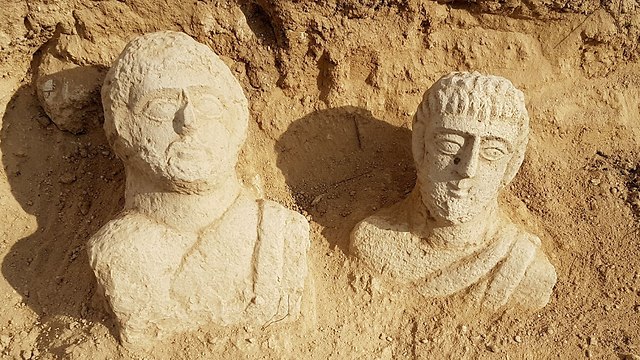
Heavy rains expose ancient statues in Beit She'an
Local woman spot the two 1,700 year-old pieces while out on a winter walk; Antiquities Authority: find offers insight into life in the Late Roman Period.
A local woman taking a winter walk near the city of Beit She'an made a startling discovery last month when she spotted two funerary statues sticking up out of the ground, apparently exposed by the rain.
The woman called the Israel Antiquities Authority, which sent a team to dig up the two statues in a joint effort with the woman and her husband. The statues have been dated to between the 3rd and 4th centuries CE, which in this area of the Levant is known as the Late Roman Period.
The unique finds have been taken to an Israel Antiquities Authority facility for further study and preservation efforts.
Dr. Itay Klein of the Antiquities Authority's unit for the prevention of the theft of antiquities said the statues are made of local limestone and closely describe facial and dress features—one of the two clearly representing a bearded man.
“Funerary statues were often located in or around burial chambers, and appear to generally describe the deceased. Similar statues have been found near Beit She'an and in northern Jordan, but no two are alike— hence the importance of this find,” Klein said.
“These two statues were made in an oriental style, testifying to the waning of the classical styles and adoption of local styles in this region during the Late Roman Period,” said Klein.
Nir Distfeld, an Antiquities Authority inspector in northern Israel said that the heavy rains the area were probably what exposed the statues. “These are very important finds that teach us a lot about the residents of ancient Beit She’an. We thank the resident who found them for showing good citizenship, and have awarded her with a certificate of honor.”
“I don’t want to think what would have happened if these statues had made it into the wrong hands. It’s important to stress that the rains could cause other archeological finds to surface, and we ask the public to report such cases,” Distfeld added
“These statues add another piece to the puzzle and allow us to better understand the culture and life of the historical residents of this area. They belong to all residents of Israel and now we can all enjoy them and learn of their historical relevance," he said.
The Late Roman Period began in the Middle East with the destruction of the Second Jewish Temple (70 CE), or as some claim, with the Bar Kokhba revolt (135 CE). As well as marking the end of Jewish aspirations to self-governance in the Palestine region, this period symbolizes the beginning of the slow decline of Pagan religions and the gradual strengthening of Christianity. It also led to the Roman Emperor Constantine’s legalization of Christianity and the rise of the Byzantine Period, which was a time of cultural and agricultural flourish.











